![]()
Tuesday, November 19, 2013
The fatal stabbing attack of an Israeli soldier at the Afula central bus station is a widespread modus operandi that is relatively easy to carry out, constituting part of the Palestinian “popular resistance” attacks. First published by the Meir Amit Intelligence and Terrorism Information Center.
Overview
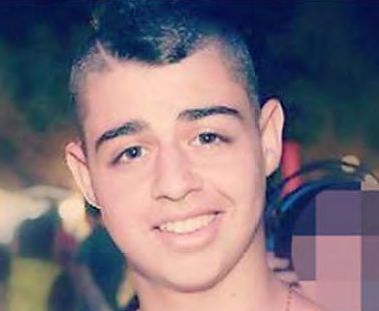
The late IDF soldier Private Eden Atias, 19, of Nazareth Illit, who was stabbed to death at the Afula central bus station (IDF Spokesman, November 13, 2013).
On November 13, 2013, an Israeli soldier was stabbed to death in Afula by a Palestinian teenager from Jenin who was illegally staying in Israel. In most (but not all) cases, stabbing attacks are carried out in a non-organized fashion by individual terrorists, (although there have been cases of couples) who do not belong to terrorist organizations. The attacks are usually carried out with knives but sometimes with axes and other sharp objects. These attacks occur in sites where Israelis congregate and at Israeli-Palestinian points of friction (such as the Jerusalem area, the Cave of the Patriarchs and Tapuach Junction in Samaria). The terrorists’ motivation may be revenge, a desire to “contribute” to the struggle against Israel or to be perceived as heroes, or a combination of these and other motives.
Stabbing attacks are part of the “popular resistance” strategy of the struggle against Israel supported by the Palestinian Authority and Fatah.[1] This strategy is not a peaceful protest (as it is presented by the Palestinian Authority). On the contrary, it makes massive use of violence that sometimes leads to casualties. The most common modus operandi is throwing stones and Molotov cocktails, but occasionally stabbing attacks or vehicular attacks[2] are also carried out. In general, these attacks have not been initiated by terrorist organizations, although Hamas and the PIJ’s incitement to step up terrorism in Judea and Samaria is also fueling the “popular resistance” attacks.
The stabbing at the Afula central bus station

The bus where the attack at the Afula central bus station took place (the Israel Police Facebook page, November 13, 2013)
On November 13, 2013, an IDF soldier, the late Private Eden Atias, 19, from the city of Nazareth Illit, was stabbed to death by a 16-year-old Palestinian terrorist. The soldier was stabbed at the Afula central bus station while en route by bus from Nazareth to the base where he served. He was fatally wounded and was rushed to Emek Medical Center in Afula, where he died of his wounds.
The Palestinian terrorist who carried out the attack is Sharif Hussein Ghawadra, 16, from the village of Bir Al-Basha, south of Jenin. According to preliminary reports, he infiltrated into Israel, was staying in the country illegally and had planned the attack in advance. During his interrogation, the terrorist admitted that he had carried out the attack to protest the fact that his relatives are serving prison terms in Israeli prisons (the Israel Police Facebook page, November 13, 2013). Two of the terrorist’s cousins are incarcerated in Israel. One of them is Shadi Ghawadra[3] and the other cousin is Muhammed Ghawadra (Palestine 24, Raya, November 13, 2013). The Palestinian media reported that after the attack, IDF forces arrested a number of the terrorist’s friends and relatives (Nablus TV, November 13, 2013).
Palestinian reactions to the stabbing attack
The Palestinian Authority
The official Palestinian Authority websites ignored the attack in Afula and refrained from commenting on the incident.
Fatah
Most senior Fatah officials chose to ignore the attack. Some key websites mentioned the attack as a purely informative report based on Israeli media reports. The official Facebook page of the Fatah Organization and Recruiting Office, which routinely lavishes praise on “popular resistance” attacks, published words of support and encouragement for the terrorist.

Comments of support and encouragement for the terrorist on the official Facebook page of the Fatah Organization and Recruiting office. The comments included the following: “Well done,” “Next,” “May your hands be blessed, hero,” “Raise your head, hero,” “May God protect you” (the official Facebook page of the Fatah Organization and Recruiting Office, November 13 and 14, 2013)
Hamas and the PIJ
The Hamas movement praised the stabbing attackin Afula, noting that it is “a natural response to the crimes of the Israeli occupation against our People and our holy sites and proof of the failure of the negotiations.” An official pamphlet issued by Hamas noted that “this heroic attack emphasizes that all Zionist terrorism and methods of oppression will not dissuade our people from proceeding along the path of jihad and resistance” (Shehab, November 13, 2013). Abu Obeida, spokesman for the military wing of Hamas, claimed that the attack in Afula was to mark the anniversary of Operation Pillar of Defense in the Gaza Strip and stressed the unity of the “Palestinian resistance” against the “Zionist enemy” (Abu Obeida’s Twitter account, November 13, 2013).
Ahmed al-Mudallal, a senior PIJ figure in the Gaza Strip, said that the “Palestinian resistance” is still continuing. He said the attack in Afula is a “natural and legitimate response” of the Palestinians against Israeli actions (Al-Resalah.net, November 13, 2013).
Stabbing attacks and their role in the “popular resistance”
“Popular resistance” is a central strategy of Fatah and the Palestinian Authority, which is implemented on the ground, and combined with the political, economic, informational and legal struggle waged by the Palestinian Authority against Israel. From the perspective of the Palestinian Authority, acts of “popular resistance” create constant and controlled tension in the Palestinians’ relations with Israel, enabling the Palestinians to exert pressure on Israel. The scope of these acts is directly related to the developments in the peace talks and to the extent which may be considered legitimate by the international community. At the same time, in the domestic Palestinian arena, the Palestinian Authority and Fatah present “popular resistance” to the Palestinian public as an acceptable alternative to the armed resistance of Hamas. In the eyes of the Palestinian Authority and Fatah, such armed resistance is not expedient at the current stage of the Palestinian struggle against Israel.
“Popular resistance” is not a peaceful and non-violent protest as it is presented by the Palestinian Authority, as it includes massive use of violence. The most common modus operandi is throwing stones and Molotov cocktails, but occasionally stabbing attacks or vehicular attacks are also carried out. These types of acts are characterized by being carried out with cold weapons and by individual terrorists rather than established terrorist organizations (although incitement by Hamas and the PIJ to increase terrorism in Judea and Samaria is fueling these attacks). In addition to “popular resistance” attacks, a small number of military attacks (shooting, abduction and murder, setting IEDs) are also carried out, but they are a marginal part of the overall number of attacks (see graph).
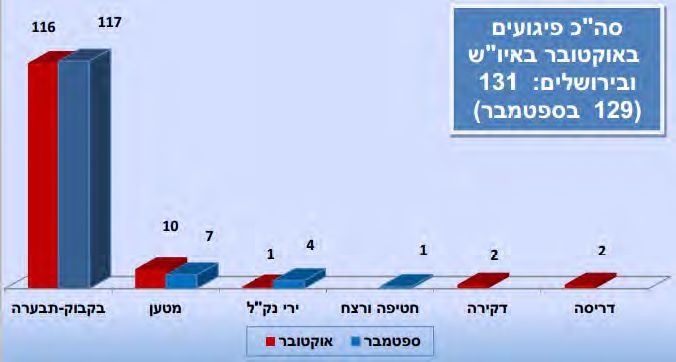
The place of stabbing attacks compared to other types of terrorist attacks in October 2013 compared to September 2013 (ISA website, November 14, 2013). The total number of terrorist attacks in October in Judea and Samaria and in Jerusalem was 131 (compared to 129 in September). The types of attacks (right to left): vehicular attacks, stabbing attacks, abduction and murder, shooting, IEDs, and Molotov cocktail attacks.
Following are some characteristics of stabbing attacks:
- Modus operandi: Stabbing attacks are usually carried out by individual terrorists although there have been cases of couples who carried out stabbing attacks. In most cases, the perpetrators are not organized and do not belong to established terrorist organizations.
- Prevalence: In recent years, stabbing attacks have been carried out every few months (during the second Intifada they were carried out every few weeks). There were four stabbing attacks in 2011, 11 in 2012, and in 2013 (as at November) there have been six (for details of the stabbing attacks in 2012 and 2013, see Appendix). In addition, there were also attempts or intentions of carrying out stabbing attacks that were foiled by the Israeli security forces and are not included in the statistics above.
- Means of attack: In most cases, the stabbing attacks were carried out using knives of various types and sizes (see photographs). In exceptional cases, these attacks were carried out with axes or other sharp objects.
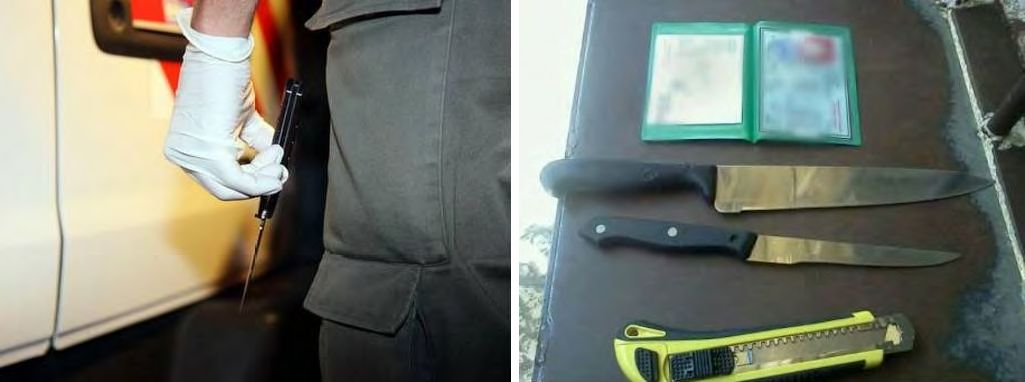
Three knives found at a checkpoint near the Cave of the Patriarchs in Hebron in the bag of a young Palestinian woman who was on her way to carry out a stabbing (Israel Police, July 1, 2013). Knife used by the Palestinian terrorist who carried out the stabbing near a Tel Aviv night club (photograph: Amir Meiri, NRG, August 29, 2011).
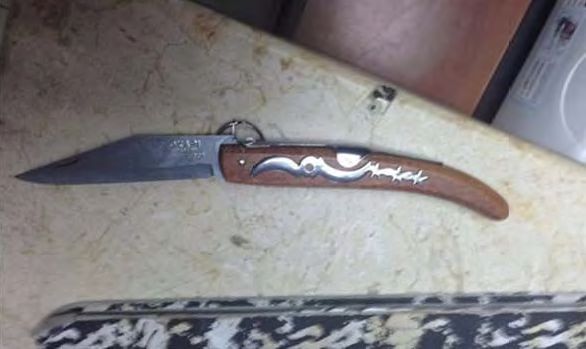
Knife found in the possession of a young Palestinian at the entrance to the Cave of the Patriarchs, who aroused the suspicions of the Border Police force stationed there. The young man was taken for questioning (photograph: Border Police Spokesman’s Office, November 17, 2013)
- Scene of attack: Stabbing attacks are usually carried out in places where Israelis congregate, usually at points of friction between Israelis and Palestinians, which are easily accessible to the perpetrators. Therefore, the Jerusalem area is a preferred location for carrying out this type of attack. However, stabbing attacks have also taken place in other points of friction in Judea and Samaria (for example, the Cave of the Patriarchs and Tapuach Junction). In several instances, stabbing attacks were carried out in population centers in Israel, such as the cities of Afula, Kfar Sava and Beersheba.
- Operational ease: Stabbing attacks are a modus operandi that can be carried out relatively easily, even by inexperienced youngsters (as in the case of the attack in Afula). This is due to the easy access to the murder weapon, the great ease with which it can be conveyed to the scene, and the lack of need for careful preparations (logistics, intelligence, operational).
- Victim’s identity: In most cases, the intention of perpetrators of stabbing attacks is to kill an Israeli Jew, without targeting a specific victim in advance. In most cases, the attack is spontaneous and the victim is random, i.e., a settler, a soldier, an Orthodox Jew or any other Israeli civilian who happened to be at the scene of the attack. In a few cases, the attack is premeditated.
- Motivation: The motives of the perpetrators may be revenge, a desire to “contribute” to the struggle against Israel, a desire to achieve the glory of a hero, or a combination of various motives. Moreover, the education that young people receive, incitement by Hamas and the PIJ, support of the “popular resistance” by the Palestinian Authority and Fatah and the prevailing anti-Israel atmosphere in the Palestinian street – all support stabbing attacks as well as other types of attacks carried out in Judea and Samaria.
Appendix
Stabbing attacks in 2012-2013[4]
Stabbing attacks with a knife (or use of axes, clubs or other sharp objects) are a fairly common modus operandi in the framework of the “popular resistance”. This modus operandi is carried out from time to time, far more infrequently than throwing stones or Molotov cocktails. Between 2001 to 2006, during the second Intifada, there were around 19 attacks per year, on average. In 2007, the number of attacks dropped to seven and in 2008-2009, there were 10-12 stabbing attacks. Seventeen people were killed in these attacks, most of them in 2001 (four fatalities) and in 2003 (three) (the ISA website: “Analysis of the characteristics of terrorist attacks in the past decade, October 29, 2000, December 31, 2009).
In 2013 (as at mid November), there were six stabbing attacks (compared with 11 in 2012) in various sites: two attacks were carried out in East Jerusalem, one in Afula, two at Tapuach Junction, and one in the northern part of the Jordan Valley. Following are details of five stabbing attacks that were carried out in 2013 (the sixth attack, in Afula, is described above):
- October 10, 2013 — Two Palestinians from the village of Dir Samet, in the Hebron area, murdered an Israeli civilian in his home in the village of Brosh, in the northern part of the Jordan Valley. The murder was carried out using a hoe and an axe that the two men brought with them. They told interrogators that they decided to carry out the attack “as a gift to the Palestinian People and Hamas prisoners on the occasion of Eid al-Adha” and to steal the victim’s weapons and other valuables (the ISA website, November 17, 2013).[5]
- July 16, 2013 — A young Orthodox father of four from Jerusalem was stabbed by two Palestinians. The young man was attacked with a knife near the Damascus Gate, on his way home from prayers on the Temple Mount. He was seriously wounded and taken to the hospital. The two perpetrators of the stabbing fled the scene (Ynet, July 16, 2013).
- April 30, 2013 — An Israeli civilian was stabbed to death at the bus stop at Tapuach Junction in Samaria. The terrorist arrived at the junction in a car, approached a group of civilians who were standing there, and stabbed one of them in the chest. The perpetrator is a minor Fatah operative from the village of Shweikah, who was released from Israeli prison (March 2013) after serving three years in prison for throwing stones. Al-Aqsa Martyrs Brigades, the military wing of Fatah, issued a statement claiming responsibility for the attack, which was presented as an act of retaliation for the deaths of two prisoners in Israeli prisons.
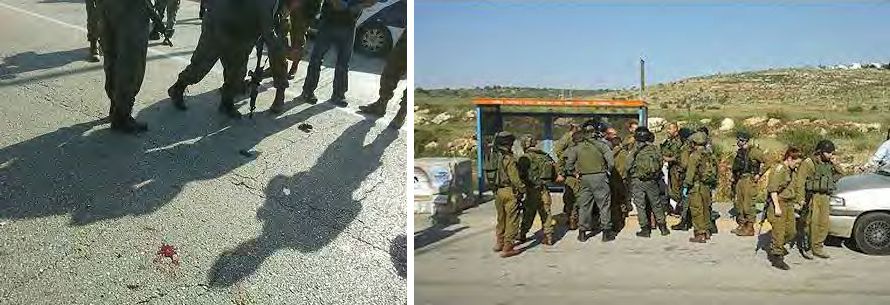
Scene of the attack at the bus stop at Tapuach Junction (Judea and Samaria Rescue Services Spokesman’s Office, April 30, 2013)
- On February 4, 2013, a stabbing attack was carried out on Sultan Suleiman Street in East Jerusalem. An Israeli civilian was lightly wounded. The perpetrator, Samer Ahmad Mahmoud Matar from the village of Idhna, was arrested the same day. During his interrogation, he confessed to the stabbing, saying that three months earlier he had begun to plan the murder of an Orthodox Jew or a settler. He also admitted his intention to carry out additional attacks, including setting a homemade explosive charge on a bus transporting Orthodox Jews. Samer Matar is a Hamas operative who was arrested and held in administrative detention in 2009-2011 (IDF Spokesman’s website, April 9, 2013).
- On January 29, 2013, an Israeli boy was stabbed near Tapuach Junction in Samaria while waiting at the bus stop. The boy was moderately wounded and taken to the hospital. The stabber was arrested by the Border Police (IDF Spokesman, January 29, 2013). The detainee is Mustafa Adel Mustafa Barghouti, resident of the village of Beit Rima, a student at Al-Najah University in Nablus. The detainee admitted that his initial objective was to murder a soldier and noted that he made the decision to carry out the attack that same morning. He looked for a soldier, and when he failed to find one, he decided to stab one of the civilians who were waiting at the bus stop (IDF Spokesman’s website, April 9, 2013).
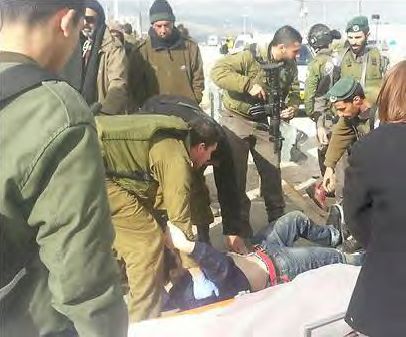
Security forces attending to the boy who was wounded in the stabbing attack (Judea and Samaria Rescue Services, January 29, 2013).
In 2012, there were 11 stabbing attacks, six of them in East Jerusalem. The main details are as follows:
- December 3, 2012 — During security operations of the Israeli security forces in Samaria, a Palestinian driving a car crashed into the security forces’ jeep. As a result, the jeep overturned and four of its passengers sustained minor injuries. The Palestinian got out of his car carrying an axe, charged at them shouting “Allahu Akbar” and wounded two of them. One of the passengers fired at the terrorist and killed him (NRG, December 3, 2012).
- November 28, 2012 — A stabbing attack was carried out in Beersheba (according to the report for the month of November 2012 on the ISA website). The stabbing victim was an Israeli college student.
- On November 22, 2012 — A Border Police soldier was stabbed and lightly wounded. The stabbing attack occurred at the entrance to an East Jerusalem police station. After the attack, dozens of Palestinian youths gathered at the entrance to the police station, and when they refused to leave, they were dispersed by force.
- On November 2, 2012 — A young Jew was stabbed in the back by two Palestinians in the East Jerusalem neighborhood of Ras al-Amud. The young man sustained light to moderate injuries.
- On June 4, 2012 — A Palestinian arrived for prayers at the Cave of the Patriarchs in Hebron. He approached a policeman who was standing at the entrance and serving as a security guard, pulled out a sharp object and stabbed the policeman. The policeman was lightly wounded. Another police officer managed to shoot the stabber, moderately wounding him.
- On April 24, 2012 — An Israeli civilian was stabbed by a resident of Ramallah on Ben Yehuda Street in the city of Kfar Sava and sustained moderate to severe injuries. Initial investigation revealed that the suspect boarded a taxi in Tel Aviv and asked to go to the village of Tuba. In Kfar Sava, he pulled out a knife and stabbed the taxi driver (Walla, April 24, 2012).
- On April 19, 2012 — An Israeli civilian was stabbed in the stomach and leg when he left the tomb of Shimon the Righteous in the East Jerusalem neighborhood of Sheikh Jarrah. The civilian was moderately wounded. On April 22, 2012, Israeli security forces arrested two residents of the Old City, who admitted to perpetrating the attack. Their interrogation revealed that prior to the attack, they had equipped themselves with knives and gloves and positioned themselves at a point overlooking the route to the tomb. They claimed that the motive for the attack was the arrest of operatives of the network known as Shabab al-Aqsa, affiliated with Hamas (the ISA website).[6]
- On April 2, 2012 — An Orthodox Israeli civilian was attacked near the Damascus Gate on his way to pray at the Western Wall. The assailant, armed with an axe, followed the Israeli civilian, attacked him in the middle of the street, and fled the scene (the ISA website).
- On March 15, 2012 — A female soldier was stabbed while riding on the Jerusalem Light Railway. The assailant pulled out a knife, stabbed her several times and fled the scene. Shortly after the attack, the perpetrator, a high school student from the village of Beit Hanina, was arrested. During his interrogation, he confessed that he carried out the stabbing for nationalistic motives and claimed that acting against the Israeli occupation is a religious obligation (the ISA website).
- On March 8, 2012 — A Palestinian terrorist attacked a Nahal soldier during an operation in the village of Yatta in the Hebron area, stabbing him in the neck with a utility knife. The soldier was lightly wounded but managed to shoot four bullets, killing the Palestinian and injuring another Palestinian who also took part in the incident (Walla, March 8, 2012).
- On January 21, 2012 — A young Palestinian stabbed a Border Police soldier at a checkpoint near the Shuafat refugee camp (northeast of Jerusalem). The policeman was lightly injured, and the attacker fled (Ynet, January 21, 2012).
![]()
Notes:
[1] For an analysis of the popular resistance and its characteristics, see our May 20, 2013 Information Bulletin: “The Palestinian “Popular Resistance” and Its Built-In Violence.”
[2] For information about vehicular attacks, see our October 22, 2013 Information Bulletin: “Vehicular Attacks: Modus Operandi Considered by the Palestinians as Part of the Popular Resistance in Judea and Samaria”.
[3] In 2003, Shadi Ghawadra shot and murdered an Israeli telecommunications company technician in Baka al-Gharbia. During a trial against the Palestinian Authority, he testified that he was sent by the military wing of Fatah (Channel 2, July 12, 2009).He was sentenced to several life sentences.
[4] These statistics include stabbing attacks carried out in Judea and Samaria and inside the State of Israel, and do not include attempted stabbing attacks that were foiled by Israeli security forces.
[5] This is not a typical stabbing attack. However, due to the manner in which the murder was committed (the use of a hoe and an axe), we have seen fit to include this incident in the list of stabbing attacks.
[6] One of the Shabab Al-Aqsa network operatives planted the explosive charge near the Jerusalem International Convention Center (March 2011). As a result, a foreign civilian was killed and 47 Israelis were wounded. The operatives were also involved in violent activity and riots on the Temple Mount.



 RSS
RSS

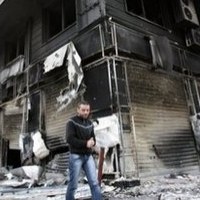
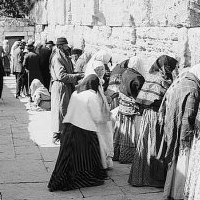

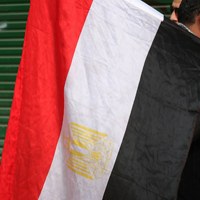
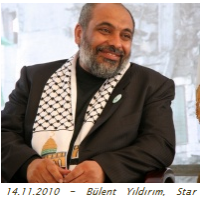




Latest Comments
Hello Mike, Thank you for your positive feedback to the article. I felt there wasn’t too much critical analysis of ...
Thanks for this considered and well constructed article. A follow up article on the manner in which the editorial contro...
THE CLUELESSNESS OF CLAIMING THAT OBAMA'S MIDDLE EAST POLICIES WERE A FAILURE CANNOT BE FURTHER FROM THE TRUTH, WHAT THE...
As long as Obama is the president of the usa do not trust the us government......
Thank you for an good read....